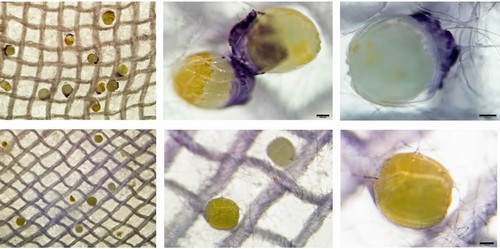Two sibling moth species Helicoverpa armigera and Helicoverpa assulta are major agricultural pests. The first is a typical polyphagous species and represents a major threat to cotton, wheat, corn, tomato, and tobacco; the second just attacks several plant species in Solanaceae such as pepper and tobacco. Although they have different host-plant ranges, both of them scatter their eggs singly on their host plants.
Odorant-binding proteins (OBPs) are small soluble proteins abundantly expressed in the lymph of chemosensilla. Regarded for many years as passive carriers for odorant molecules to the membrane-bound olfactory receptors, now they are being recognized as the proteins responsible for detecting and discriminating the different olfactory messages.
Professor Chen-Zhu Wang’s team recently found a very interesting OBP, OBP10, which was specifically expressed in the antennae of both sexes of both species, being absent from other sensory organs. However, it was also highly abundant in the sperm fluid, from which it was transferred to females during mating and eventually found on the surface of fertilized eggs.
Consequently, ,the researchers asked the question if OBP10 could act as a carrier for some semichemicals. The GC/MS analysis of crude dichloromethane extracts of reproductive organs of males in both species showed several hydrocarbons, as well as medium chain aldehydes and other compounds could be detected and bound to OBP10, but the fractionation of a crude extract from male reproductive organs of both species on a gel filtration column and analysis of each fraction by SDS-PAGE, Western blot and GC/MS after extraction with dichloromethane showed that the ligand most likely associated with OBP10 was 1-dodecene. The Ligand-binding experiments with recombinant protein verified a good affinity to 1-dodecene. The structure of OBP10 was similar with OBP1 of the mosquito Culex quinquefasciatus, a protein reported to bind an oviposition pheromone.
Based on above results, this team suggests that OBP10 could be a carrier for oviposition deterrents besides of its function in olfactory reception. The female moths perceive the semiochemical (1-dodecene) through the antennae immediately after laying the first egg, and then move to other locations for continuing its egg laying process, thus reducing cannibalistic habits of this and related species. This is a good case that OBPs play dual roles in insect chemical communication.
This paper has been published in PLoS ONE(Sun YL, Huang LQ, Pelosi P, Wang CZ, 2012. Expression in antennae and reproductive organs suggests a dual role of an odorant-binding protein in two sibling Helicoverpa species. PLoS ONE 7(1): e30040.)

Immunostaining of OBP10 on the eggs of H. assulta.
Eggs that had been laid on a piece of cotton were directly stained with the antiserum against OBP10, following the same protocol as for Western blot analysis. The upper panels show fertilized eggs at different magnifications. The lower panels show parallel experiments performed with unfertilized eggs, collected from females that had never been in contact with males. The heavy staining is specifically associated with fertilized eggs on the tip opposite to the micropyle. Calibration bars: 100 µm.

